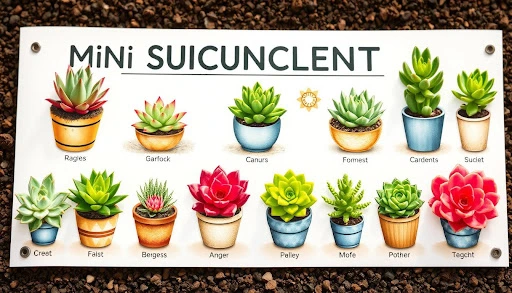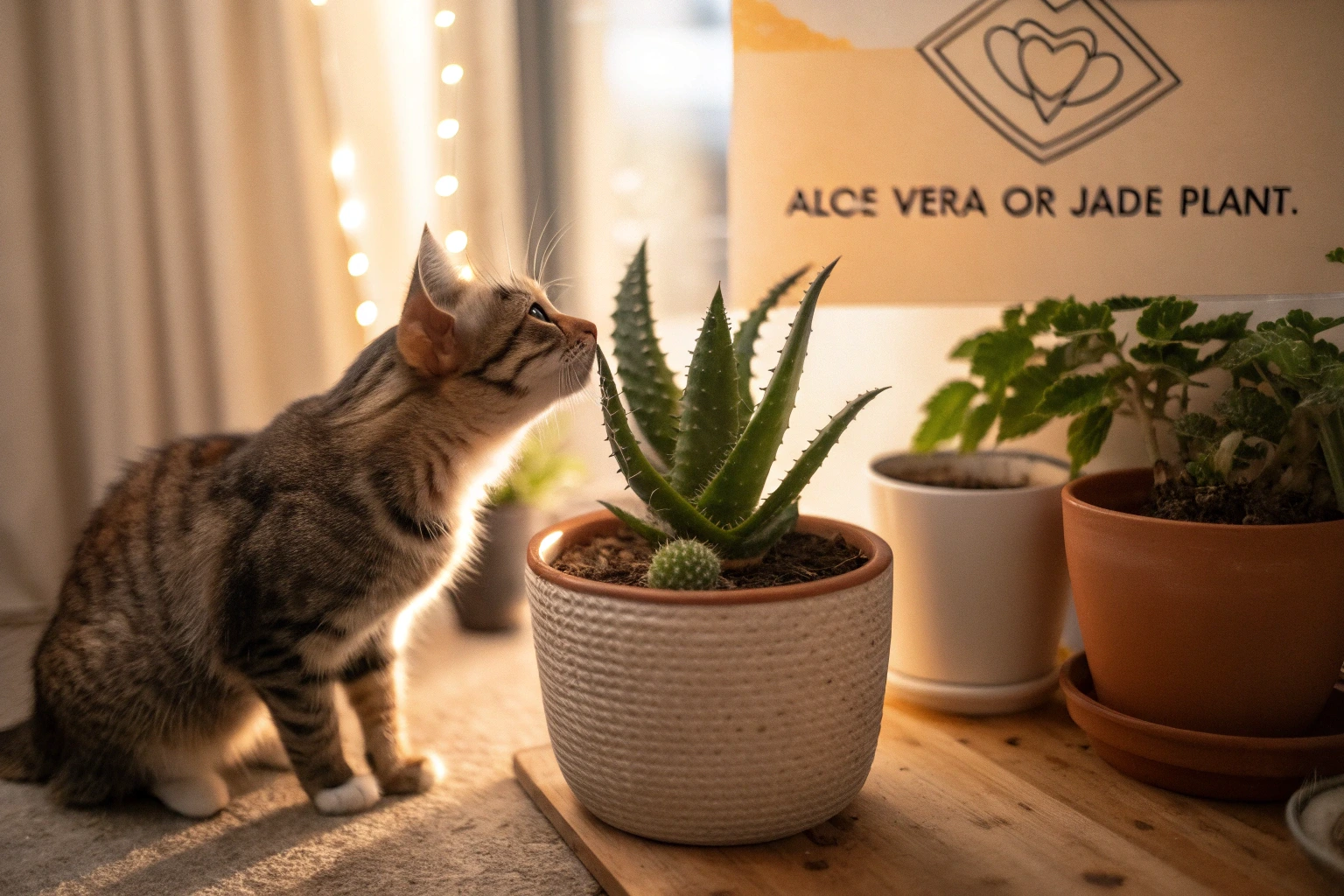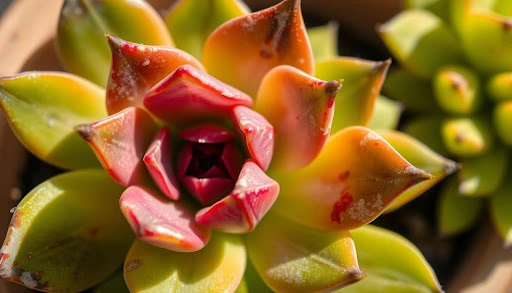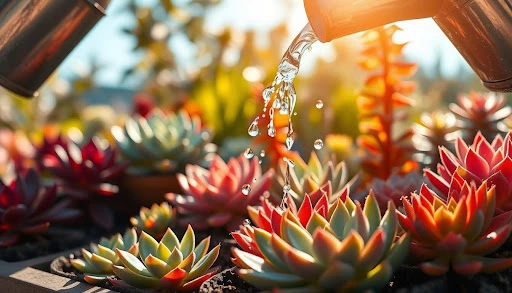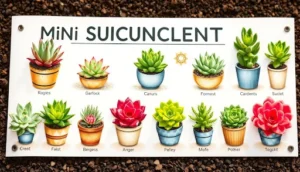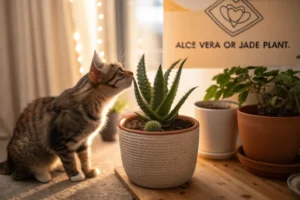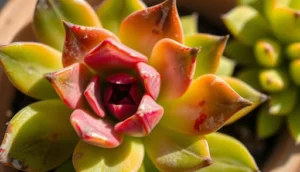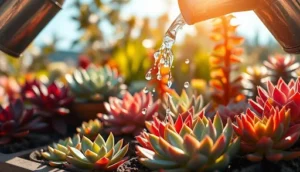Ever walked into a plant shop and been captivated by a quirky succulent that looks like a miniature jade plant but isn’t quite one?
That’s probably the Portulacaria Afra, affectionately known as the elephant bush or spekboom.
I have been growing these fascinating plants for years, and let me tell you – they are not just another pretty face in the succulent world.
What is Portulacaria Afra?
Native to South Africa, Portulacaria Afra is a remarkable succulent that’s been turning heads in the plant community for all the right reasons.
In its natural habitat, it can grow into a small tree up to 15 feet tall! But don’t worry – in your home, it will stay much more manageable.

What makes this plant truly special is its dual identity.
While it’s becoming increasingly popular as a houseplant, in South Africa, it’s actually a crucial player in environmental conservation.
According to the South African National Biodiversity Institute, a single hectare of Portulacaria Afra can sequester up to 4.2 tons of carbon per year – that’s about the same as taking four cars off the road!
The Surprising Environmental Superhero in Your Garden
Carbon Sequestration: How This Tiny Plant Fights Climate Change
Here’s something that’ll knock your gardening gloves off: Portulacaria Afra is one of the most efficient carbon-sequestering plants on the planet.
While most plants use the standard C3 photosynthesis pathway, this clever little succulent employs CAM (Crassulacean Acid Metabolism) photosynthesis, allowing it to store massive amounts of carbon dioxide during the night.
But here’s the real kicker – one hectare of Portulacaria afra can sequester up to 4.2 tons of carbon per year.
That’s roughly equivalent to taking four cars off the road!
In South Africa’s spekboom thickets (large areas where Portulacaria afra grows naturally), these plants work overtime as nature’s air purifiers.
They’re so effective that conservation projects are using them to rehabilitate degraded landscapes and combat climate change.
Pretty impressive for a plant that fits in your coffee cup, right?
Drought Resistance: Thriving When Others Wilt
But wait – there’s more to this botanical Batman.
Portulacaria Afra laughs in the face of drought.
While other plants wither and wilt during dry spells, this tough cookie can survive on mere whispers of water.
Its secret? Those chubby leaves aren’t just for show – they’re sophisticated water storage units.
During extreme drought, Portulacaria Afra performs a neat trick called “drought deciduous behavior.”
It will drop some leaves to conserve water, but keep its stems green and alive, ready to bounce back the moment water becomes available.
Think of it as the plant equivalent of hibernation, but way cooler.
Even more fascinating? This succulent can switch between normal C3 photosynthesis during favorable conditions and water-efficient CAM photosynthesis during drought.
It’s like having a car that can switch between regular gas and super-efficient hybrid mode whenever needed.
This adaptability makes it an absolute champion in our increasingly unpredictable climate.
In the wild, these survival skills make Portulacaria Afra a crucial species for preventing soil erosion and maintaining ecosystem health.
In your garden? It means you have got yourself a resilient little trooper that won’t throw a tantrum when you forget to water it for a few weeks.
Now that’s what I call a low-maintenance relationship!
Varieties and Forms
Before we dive into care instructions, let’s explore some popular varieties of Portulacaria Afra you might encounter:
1. Portulacaria Afra ‘Variegata’
- Cream-colored leaf margins
- Slower growth than the standard form
- More sensitive to direct sunlight

2. Portulacaria Afra ‘Prostrata’
- Low-growing, trailing form
- Perfect for hanging baskets
- Smaller leaves than the standard variety

3. Portulacaria Afra ‘Cork Bark’
- Distinctive cork-like trunk texture
- Highly prized for bonsai
- Slower growing than standard form

4. Portulacaria Afra ‘Medio-Picta’
- Cream-colored centers on leaves
- Rare and collectible
- Requires careful light management

8 Stunning Varieties That will Make Your Collection Pop
Just when you thought Portulacaria Afra couldn’t get any more impressive, wait until you meet its fabulous family members.
Each variety brings its own unique flair to the succulent scene, turning ordinary spaces into botanical wonderlands.
Rainbow Bush: The Variegated Beauty
Let’s start with the showstopper – Portulacaria Afra ‘Variegata’, aka the Rainbow Bush.
Picture this: cream-colored leaf margins dancing around emerald green centers, creating a mesmerizing pattern that catches light like natural stained glass.
But here’s the twist – stress these beauties with bright light, and those creamy edges blush into gorgeous pink hues.
Talk about a plant with personality!
The variegated form grows slightly slower than its green cousin, but what it lacks in speed, it makes up for in drama.
Each new leaf unfolds like a tiny work of art, with patterns as unique as fingerprints.
Pro tip: give these stunners slightly more shade than regular Portulacaria Afra to prevent leaf burn while maintaining those striking variegations.
Prostrata: The Trailing Dream
Meet the waterfall of the succulent world – Portulacaria Afra ‘Prostrata’. Instead of reaching for the sky, this rebel cascades down in elegant streams of tiny leaves.
Its prostrate growth habit makes it perfect for hanging baskets, where stems can trail up to three feet long!
The leaves on ‘Prostrata’ are typically smaller and more densely packed than the standard variety, creating a lush, carpet-like appearance.
When sun-stressed, the stems take on a gorgeous reddish tint, adding another layer of visual interest.
Imagine this beauty spilling over the edges of a tall pot or creating living curtains in a bright window.
Mini Jade: The Compact Cutie
Don’t let its diminutive size fool you – Portulacaria Afra ‘Minima’ packs all the charm of its larger relatives into an adorably compact package.
This miniature version sports leaves about half the size of the standard variety, making it perfect for small spaces and fairy gardens.
The ‘Minima’ grows in a dense, bushy pattern, naturally forming a perfect little bonsai-like shape without much pruning needed.
Its smaller leaves and tight growth pattern make it an excellent choice for creating miniature landscapes or adding texture to succulent arrangements.
Plus, its compact size means you can fit more plants on your windowsill – and who doesn’t want that?
Each of these varieties brings something special to the table, and they all share the same tough-as-nails constitution that makes Portulacaria afra such a beloved plant.
Whether you’re drawn to the rainbow colors, the cascading growth, or the cute mini versions, there’s a variety that’s perfect for your space.
Medio-Picta: The Reverse Variegated Wonder
Here’s a real collector’s gem – Portulacaria afra ‘Medio-Picta’.
Unlike its variegated cousin, this stunner sports a creamy yellow center with green edges.
It’s like nature decided to paint from the inside out!
These rare beauties grow slower but offer unmatched elegance.
Cork Bark: The Textural Marvel
The ‘Cork Bark’ variety brings something entirely different to the table.
As it ages, its stems develop a fascinating cork-like texture, giving it an ancient, weathered look.
Perfect for bonsai enthusiasts, this variety adds architectural interest to any collection.
Aurea: The Golden Child
Portulacaria Afra ‘Aurea’ lights up any space with its naturally yellow-green foliage.
In bright light, the leaves take on a warm, golden glow that can add a surprising pop of color to succulent arrangements.
It’s like having permanent sunshine in your collection!
Macrophylla: The Giant
Think regular Portulacaria Afra leaves are impressive?
Meet ‘Macrophylla’, the giant of the family. With leaves nearly twice the size of the standard variety, this statement plant demands attention.
Its robust growth and larger leaves make it perfect for creating dramatic indoor trees.
Iceberg: The Frosty Beauty
Last but certainly not least, the ‘Iceberg’ variety sports nearly white leaves with just a hint of green.
This delicate-looking beauty requires a bit more care to maintain its pristine coloration, but the ethereal effect is worth every extra effort.
Under ideal conditions, it creates an almost otherworldly display.
Each of these varieties brings something special to the table, and they all share the same tough-as-nails constitution that makes Portulacaria Afra such a beloved plant.
Whether you’re drawn to the rainbow colors, the cascading growth, or the architectural forms, there’s a variety that’s perfect for your space and style.
Is Porulacaria Afra An Indoor Plant?
I often get asked, “Is Portulacaria Afra an indoor plant?” The short answer is yes, but with some caveats.
While these tough little succulents naturally grow outdoors in South Africa’s Eastern Cape, they’ve adapted remarkably well to indoor living.
Here’s what you need to know:
Does Portulacaria Need Full sun? Finding the Sweet Spot
Well, it’s complicated. Here’s my tried-and-tested advice:
- Indoors: Place your plant near a bright window with:
- 4-6 hours of direct morning sun
- Protection from harsh afternoon rays
- Bright indirect light for the rest of the day
- Outdoors: If you’re lucky enough to live in USDA zones 9-11, you can grow it outside with:
- Morning sun exposure
- Afternoon shade in hot climates
- Full sun in coastal areas
How often should I water my Portulacaria Afra
One of the most common questions I get is, “How often should I water my Portulacaria Afra?” Let me break it down for you:
Watering Schedule
| Season | Frequency | Key Points |
| Spring/Summer | Every 7-10 days | Check soil first |
| Fall | Every 2-3 weeks | Reduce gradually |
| Winter | Every 3-4 weeks | Minimal watering |
The golden rule? Always check the soil before watering. I stick my finger about an inch into the soil – if it’s still moist, I wait a few more days.
Advanced Watering Tips
- Water Quality Matters
- Use filtered or rainwater when possible
- Avoid softened water
- Let tap water sit overnight to dissipate chlorine
- Watering Technique
- Water at the base of the plant
- Avoid getting leaves wet
- Ensure good drainage
- Empty saucer after watering
Soil and Potting
Success with Portulacaria Afra starts with the right soil mix. Here’s my personal recipe:
- 50% cactus/succulent mix
- 25% perlite
- 25% coarse sand or pumice
Potting Tips
- Choose the Right Container
- Use pots with drainage holes
- Terra cotta works best
- Size up only 1-2 inches when repotting
- Repotting Process
- Best done in spring
- Gently remove old soil
- Inspect and trim roots
- Keep plant at original depth
Propagation: Growing Your Collection

One of the most rewarding aspects of growing Portulacaria Afra is how easily it propagates. Here’s how to multiply your plants:
Stem Cutting Method
- Taking Cuttings
- Choose healthy stems 3-4 inches long
- Make clean cuts just below a node
- Remove lower leaves
- Let callus for 2-3 days
- Planting Process
- Use well-draining propagation mix
- Insert stem about 1 inch deep
- Keep soil slightly moist
- Roots develop in 2-3 weeks
Leaf Propagation
While possible, leaf propagation is slower and less reliable than stem cuttings. If you want to try:
- Choose healthy, plump leaves
- Let them callus for 1-2 days
- Place on well-draining soil
- Mist occasionally
- Wait for tiny roots to appear
Seasonal Care Guide
Spring (Growing Season)
- Resume regular watering
- Start fertilizing
- Perfect time for propagation
- Ideal for repotting
Summer (Peak Growth)
- Protect from intense afternoon sun
- Increase watering frequency
- Monitor for pests
- Prune as needed
Fall (Transition)
- Gradually reduce watering
- Stop fertilizing
- Move sensitive plants indoors
- Clean leaves
Winter (Dormancy)
- Minimal watering
- No fertilizer
- Protect from cold drafts
- Watch for etiolation
Growing Tips: Speed Up Your Success
Want to know how to make your Portulacaria Afra grow faster? Here are my top tips:
- Temperature: Keep it between 65-80°F (18-27°C)
- Humidity: Average room humidity is fine
- Soil: Use well-draining cactus mix
- Fertilizer: Feed monthly during growing season with:
- Balanced liquid fertilizer (10-10-10)
- Diluted to half strength
Bonsai Techniques
Portulacaria Afra makes an excellent bonsai subject, often called “dwarf jade” in bonsai circles. Here’s how to start:
Basic Bonsai Styling
- Pruning
- Regular pinching of new growth
- Remove crossing branches
- Maintain proportional growth
- Wiring
- Use aluminum wire
- Wire when branches are flexible
- Remove wire before it scarring
- Pot Selection
- Shallow bonsai containers
- Good drainage essential
- Match pot size to tree
Why Is My Portulacaria Dropping Leaves?
Don’t panic! Leaf drop is usually caused by:
- Overwatering (Most common)
- Temperature shock
- Insufficient light
- Pest problems
The solution? First, check the roots. If they’re brown and mushy, you are overwatering. If they are white and firm, look at environmental factors like temperature and light.
Pest Management
Common pests include:
- Mealybugs
- Spider mites
- Scale insects
Treatment options:
- Isolate affected plants
- Remove pests manually
- Apply neem oil solution
- Use insecticidal soap if needed
The Blooming Question: Do Portulacaria Afra Bloom?

Yes, they do! But here’s the catch – flowering is rare indoors. In their natural habitat, they produce tiny pink star-shaped flowers in late spring to early summer. To encourage blooming:
- Provide lots of bright light
- Keep temperatures between 70-85°F (21-29°C)
- Reduce water slightly during winter
- Be patient!
The Impressive Benefits of Portulacaria Afra
Beyond its ornamental value, this plant is a powerhouse of benefits:
- Environmental Impact
- Carbon sequestration champion
- Drought-resistant
- Prevents soil erosion
- Cultural Significance
- Traditional medicine in South Africa
- Important food source for wildlife
- Used in traditional ceremonies
- Practical Benefits
- Air-purifying properties
- Low maintenance
- Long lifespan (50+ years with proper care)
What Is The Lifespan Of a Portulacaria and Long-Term Care
Speaking of lifespan, how long can you expect your Portulacaria Afra to stick around?
With proper care, these plants can live for several decades. I have seen specimens in botanical gardens that are over 50 years old!
Tips for Longevity:
- Regular Pruning
- Trim in spring
- Remove dead or yellowing leaves
- Shape as desired for bonsai
- Repotting
- Every 2-3 years
- Use slightly larger pot
- Fresh soil mix
Conclusion
Portulacaria Afra is more than just a pretty succulent – it’s a resilient, beneficial, and fascinating plant that can bring years of joy to any plant enthusiast.
Whether you’re a beginner or an experienced gardener, this adaptable plant deserves a spot in your collection.
Ready to start your Portulacaria Afra journey?
Remember: bright light, well-draining soil, and careful watering are your keys to success.
Share your experiences in the comments below – I will love to hear how your elephant bush is thriving!
FAQs
Q: Where Should I Place My Elephant Bush?
Place your Portulacaria Afra, also known as the Elephant Bush, in a bright location with plenty of indirect sunlight or direct morning light.
For outdoor placement, ensure it gets 4-6 hours of sunlight daily in a well-draining soil area. Indoors, position it near a south- or west-facing window to provide sufficient light.
Avoid areas with cold drafts, as the plant prefers warmer conditions.
In regions with frost, keep it indoors during winter to protect it from freezing temperatures.
Proper placement ensures healthy growth and vibrant foliage.
Q: How Fast Does Portulacaria Afra Grow?
Portulacaria Afra has a moderate to fast growth rate under optimal conditions. In warm climates with ample sunlight, it can grow 12-24 inches per year.
Growth slows in cooler or less sunny environments.
Proper care, including well-draining soil, regular watering during the growing season, and occasional feeding with a balanced fertilizer, encourages faster growth.
However, being a succulent, its growth may be slower than non-succulent plants but is relatively quick compared to other succulents.
Q: Can I Trim Portulacaria?
Yes, you can trim Portulacaria Afra to maintain its shape, size, and health.
Trimming encourages branching and fuller growth. Use sharp, clean scissors or pruning shears to remove leggy, overgrown, or unhealthy stems.
Prune during its active growing season, spring or summer, for the best results.
Avoid excessive trimming in winter when the plant is dormant.
Ensure not to remove more than one-third of the plant at a time to prevent stress.
Q: Is Portulacaria an Indoor Plant?
Yes, Portulacaria Afra can thrive as an indoor plant, provided it receives adequate sunlight.
Place it near a sunny window with 4-6 hours of indirect or filtered light daily.
Its compact size and low-maintenance nature make it an excellent choice for indoor spaces.
However, ensure proper airflow, avoid overwatering, and use a well-draining soil mix to prevent root rot.
Under ideal indoor conditions, the plant will retain its vibrant green leaves and thrive.
Q: Can You Grow Portulacaria Afra From Cuttings?
Yes, Portulacaria Afra is easy to propagate from cuttings.
Select a healthy stem and cut a 3-5 inch section below a node. Allow the cutting to dry for 24-48 hours to form a callus, which prevents rot.
Plant it in well-draining soil and water sparingly until roots develop, typically within 2-4 weeks.
Keep the cutting in a warm, bright location with indirect sunlight during this period.
Q: Does Portulacaria Afra Need Water?
Portulacaria Afra requires moderate watering, thriving in a “soak and dry” watering method.
Allow the soil to dry completely between waterings to avoid root rot.
During the active growing season (spring and summer), water every 7-10 days.
In cooler months, reduce watering to once every 3-4 weeks.
Ensure the pot has drainage holes to prevent water retention.
Q: How Can I Make My Elephant Ears Grow Faster?
To encourage faster growth, provide your Portulacaria afra with bright, indirect sunlight for at least 6 hours daily.
Use well-draining soil and water consistently during its active growing season.
Fertilize with a balanced succulent fertilizer every 4-6 weeks in spring and summer.
Maintain a warm temperature (65-85°F) and avoid overwatering.
Proper care will result in healthier, faster growth.
2: What is the Problem With Portulacaria Afra?
The most common issues with Portulacaria Afra include overwatering, which leads to root rot, and insufficient light, causing leggy growth.
Pests like mealybugs and spider mites can occasionally infest the plant.
Additionally, yellowing leaves often indicate overwatering or poor drainage.
Addressing these issues promptly ensures the plant remains healthy and vibrant.
Q: How Do I Know If My Elephant Bush is Overwatered?
Signs of overwatering include yellowing, mushy leaves, and a soft, discolored stem.
The plant may also develop root rot, leading to a foul smell and wilting despite moist soil.
Ensure the pot has proper drainage, and let the soil dry out completely before watering again.
Q: Can Portulacaria Afra Grow in Shade?
Portulacaria Afra can tolerate partial shade but prefers bright, indirect light.
While it may survive in shaded areas, its growth will slow, and the foliage may lose vibrancy.
For optimal health and color, ensure at least 4-6 hours of sunlight daily.
Q: What Eats Portulacaria Afra?
Portulacaria Afra is occasionally browsed by animals like elephants in its native habitat, hence its name.
However, in home settings, pests like mealybugs, aphids, and spider mites are common culprits.
Regularly inspect the plant and use neem oil or insecticidal soap for pest control.
Q: Why is My Portulacaria Afra Turning Yellow?
Yellowing leaves often indicate overwatering or poor drainage.
Ensure the soil dries out completely between waterings.
Other potential causes include inadequate sunlight, pest infestations, or nutrient deficiencies.
Addressing these factors promptly will help restore the plant’s health.
Q: What’s the Best Fertilizer for Elephant Plants?
A balanced, water-soluble fertilizer with equal ratios of nitrogen, phosphorus, and potassium (e.g., 10-10-10) is ideal for Portulacaria Afra.
Apply during its active growing season, every 4-6 weeks, to promote healthy growth.
Avoid over-fertilizing, as it can harm the plant.
Q: Does Portulacaria Afra Flower?
Yes, Portulacaria Afra can produce small, star-shaped pink or white flowers under ideal conditions.
However, flowering is rare in indoor plants and more common in mature plants growing outdoors in warm climates.
Blooming typically occurs in late spring or early summer.
Q: How Do You Prune Portulacaria Afra?
Prune Portulacaria Afra during its active growing season to maintain its shape and encourage branching.
Use sharp, sterilized pruning shears to remove leggy, damaged, or overcrowded stems.
Focus on cutting just above a node to stimulate new growth, but avoid over-pruning.

